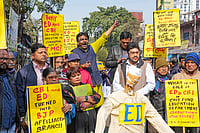Barring minor quibbles, industry is valiantly trying to show a happy countenance to the world. The fringe benefit tax stays, albeit without the most offending provisions. Many had actually had a sneaking belief that it will go. It’s a tax that even economists have opposed, especially with regard to its implementation. The cash transaction tax stays too, for some time at least. And the securities transaction tax is higher by 25 per cent. Of course, nobody really believed Chidambaram would scrap these taxes. In a post-budget interaction, a mildly agitated Sunil Mittal, telecom tycoon, summed up the real response to the budget. He had to ask the last but one question to Chidambaram who was to rush off for a US business meeting in about five minutes. Mittal, who wanted to complain about the high tax incidence on telecom, was firm: "I’ll try to be brief but I have to make a case. You will not listen to me unless I make a case."
But industrialists in other sectors were less touchy. R. Seshasayee, MD, Ashok Leyland, says: "By introducing no new taxes, the FM has signalled a stable tax regime based on moderate tax rates, widening of the base and better compliance." Adds Tata Steel MD, B. Muthuraman: "This year’s budget has laid stress on continuity of policies for sustaining the growth momentum in the economy. The FM has tried to put his programme on autopilot. Change should not be made just for the sake of change and I feel this budget will provide stability." P. Prabhakar, president, Indo-American Chamber of Commerce, too found little fault with the budget.
Of course, a good finance minister needs to be adept in raising resources. Especially in a country like India where, for years, well-meaning babus—and even some ministers—have battled with controlling expenditure, and thereby the budget deficit, only to have their efforts frustrated by their seniors in politics. In contrast, Chidambaram has been easily the most successful finance minister in single-mindedly pursuing revenues with a view to controlling the fiscal situation. This year’s budget numbers show how (see chart).
For the past two years, Chidambaram has budgeted for and actually got an over 20 per cent increase in all major tax collections, barring excise which is dragged down by primarily the oil sector. Result: total tax revenues are up 22 per cent over the actuals in 2004-05, and will overshoot even the budget target for the ongoing fiscal year. Buoyed by this, PC has budgeted a 20 per cent higher tax collection for next fiscal too, though if the Index of Industrial Production (IIP) slows down further and corporate profit growth stabilises, the target may fall through. The only consolation is that the brunt of the hike is borne by service tax. By increasing the rate to 12 per cent and bringing 15 more services into the net, PC has practically doubled the collection target to Rs 34,500 crore in a single year! Grumbles Alok C. Misra, Group CFO, MphasiS: "The marginal benefit occurring out of FBT will be wiped out by the increase in service tax." Adds Ramesh Sobti, country representative, ABN Amro Bank: "The proposal to bring ATM operations under the purview of the service tax is biased against all technologically-savvy consumers. Within the banking industry, this proposal distorts the playing field between banks which have a brick-and-mortar presence and those which have expanded their presence through the ATM route."
With this, the tax-GDP ratio finally goes above 11 per cent and the total tax take will more than double since 2003. That’s a mere three years! The importance of the sharp rise in revenues is realised when one looks at the capital receipts which are visibly lower. Thanks to the twelfth Finance Commission, loan recoveries are less at Rs 11,700 crore this year and will fall further to Rs 8,000 crore next fiscal. Even borrowings have dropped one-third to Rs 1,46,175 crore. The situation was saved somewhat by Rs 2,356 crore of other receipts, which are actually proceeds of Balco and Maruti disinvestments (disinvestment money is going to the National Investment Fund only next year).
Thanks to the growth boost to revenues, Chidambaram has managed to add substantially to plan allocations this year, thus making the National Advisory Council and its chairperson Sonia Gandhi happy. All the eight priority welfare programmes of theUPA, especially Bharat Nirman and NREGs, are flush with funds, and it is not just a token gesture. Budgetary support for the central plan fell short of target this fiscal, and will therefore be 22 per cent more next year.
To cap it all, there’s a host of price cuts (owing to customs and excise duty reductions) for products ranging from small cars (with a most baffling engine size) to ice cream to packaged foods. Even after distributing the goodies, Chidambaram has managed to track his way back to fiscal correctness. His revenue gap is down to 2.6 per cent of GDP this year. Next year, the fiscal deficit will be under four per cent of GDP—that’s no mean feat surely. But an even more impressive feat would be to wipe out the remaining revenue deficit in the next two years, since 2008-09 is the deadline set as per the FRBM Act—since the sixth pay commission will presumably have to be set up in the meanwhile.
In his budget speech, the FM mentions that for the first time in 2004-05, the gross fiscal deficit has fallen below the gross budgetary support for the plan. Which means a small portion of the fresh investments in the economy is not coming from borrowing anymore. If this is a reform in the right direction, the minister messes it up by announcing short-term credit for farmers at 7 per cent. Apart from subverting the credit market, this will also involve a "subvention" to Nabard, which will happen in due course. This scheme is over and above an interest relief scheme worth Rs 1,700 crore on loans already granted.
Post-budget, Chidambaram said that the big idea was "growth from agriculture". If that is so, he has surely chosen a very mysterious way to get it. There are three reasons why the credit scheme won’t work to improve the lot of the average farmer. One, it has been proved, especially in India, that the problem with farm credit is not its cost but its availability and the access barriers. Secondly, to tie a very small farmer to an uneconomic activity by providing cheap credit is probably wrong, when statistics show that over half of rural incomes come from non-farm activities. What the marginal farmer needs is employment opportunities, and those can be offered by a vibrant rural economy. Thirdly, price, seeds, technology and market problems also determine the fate of a crop. Why then such a long deadline for the unified goods and services tax that would have broken barriers across states? Says S.K. Poddar, president, FICCI: "A major positive feature of the budget is the signal given on the introduction of a comprehensive Goods and Services Tax by 2010. This should serve to integrate the economy and make India a single common market. I hope that the timeline on implementation of gst would be adhered to." We hope so too.
Ultimately, a concrete boost to the rural economy is absent from the budget. Instead, more than anything else, it spends a lot of money on social sectors, some of which should ideally impact the rural economy in a multiplier effect. But that’s a formula tried and failed. Some other initiatives are more laudable. There is for the first time, gender budgeting, which has made organisations like CRY and Haq Centre for Child Rights protest over the lack of child budgeting. But there is also a nice little scheme for the girl child, which ensures that she studies till she becomes 18 (and hopefully remains unmarried too). This single plan, if implemented correctly by women panchayat heads, could do more for backward classes than all the nac schemes put together. Now if only there was some original thinking like this for the food subsidy!
Talking of the food subsidy, none of the issues sensitive to the upa partners—petroleum price hike, subsidies, insurance fdi limit, disinvestments—have been tackled in the budget, though some of them find oblique mention. Next year, the government hopes to net Rs 3,840 crore from part-disinvestments in the National Mineral Development Corporation and Power Finance Corporation, says a paragraph in the receipts budget. The FM himself says that he would "work on a consensus" from partners on the petroleum price issue. The survey frowns on the pay commission issue, so presumably North Block doesn’t want that too. But with five states going to the polls, it is clear that the budget doesn’t even try a balancing act on such issues. Far better then to leave the contentious issues to the CMP, as Chidambaram himself said, and "go to bed happily with my conscience as guide". Far better to be safe than sorry.
North Block officials admit that after the bold tax experiments last year (taxpayers might like to call it painful) the brief this year was to tread on the light side. No tinkering of rates, no new taxes, no cess—definitely nothing that evokes an outrage. They call it "consolidation"—why fix a formula when it ain’t broken? As for the EET (exempt-exempt-tax or taxing of saving at maturity) regime for all instruments, says advisor Parthasarathi Shome, "it will come in due course. We didn’t find it necessary to announce it in the budget." Even the FM said that "we have already declared that this is our intention". They also protest that the budget should be just a working plan for the next year, not read as a framework of policy. Especially policy concerning other ministries and departments.
Why then a total bypass of the financial sector, which comes under North Block? There are a few measures to boost the capital market—a rise in the ceilings on fii investment in bonds, and on outbound investment by mutual funds—but that’s about all. Even in manufacturing, where a preference is made obvious, the accent is more on a revenue boost than on policy. The long-term goal behind the excise cut in cars is intended to make India a global manufacturing hub of small vehicles. Says Jagdish Khattar, MD, Maruti Suzuki: "The FM has outlined a vision for making India a global manufacturing hub, for textiles, steel, metals, petroleum products and automobiles. The excise reduction will help us get there." But others disagree. Even the textiles sector, which has apparently got a number of sops, is not entirely happy. Says Sanjay Lalbhai, MD, Arvind Mills, "Reduction in excise duty and import duty on man-made fibres has fully removed their disadvantage against cotton and brought in the parity. This will encourage production of spun yarn and blended yarn and improve their competitiveness. But vat is required to be extended to the textile sector. The industry would have also welcomed definite plans on internal reforms in areas like the cost of power and labour."
India needs a revamp of the labour laws and major action on the power front to get manufacturing going and the FM is predictably silent on this. Such contradictions abound in the budget. Says economist Bibek Debroy: "Although the finance minister declares that growth is the best antidote to poverty, he gives large sums of money to anti-poverty flagship programmes of dubious efficiency and delivery." Adds Saumitra Chaudhuri, economic advisor, ICRA: "The subsidy number in the budget is only Rs 46,213 crore, but it will have to be more than this if one has to take into account the provisions for lpg and kerosene." Quite, since nobody knows when the ‘pass-throughs’ will be effected, perhaps not till June. There is also a provision for end of the year borrowing in March.
Similarly, some vital sectors are completely neglected. Says Kiran Mazumdar-Shaw, CMD, Biocon: "I am disappointed that the budget has not provided for incremental investment in science and technology. We want the extension of the weighted average deduction of 150 per cent for R&D expenditure till March 2015 but this has not been addressed." Adds Prathap C. Reddy, chairman, Apollo Hospitals group: "While we welcome reduction of customs duty on cancer and anti-aids drugs, there is no specific focus in the budget to increase healthcare access for people or promote growth in healthcare sector, especially cardiac research. Health can contribute to a double-digit growth by also impacting the employment potential."
This year, Chidambaram has made sure that the hype surrounding the budget is nil. Says Analjit Singh, chairman, max Group: "The budget used to be the ‘mantra for business’. Today, it has lost its significance in a relative sense. Besides, there is nothing magical about policy pronouncements on February 28!" On a closer reading of the budget, the FM downplaying the budget may have been entirely justified!
Even the duty cuts may not satisfy the US business steam. Says Arvind Panagariya, professor, Columbia University: "Not a bold budget by any means. A bolder budget would have cut the peak custom duty to 10 per cent and entirely eliminated the ssi reservation list. Several items outside the peak tariff—most notably automobiles—needed deeper cuts since there is no sensible case for holding on to 50 per cent-plus custom duties on these items." Whether Chidambaram’s mild budget is a success or not will be known next year. As the FM himself said, "you must give me marks on the past budget, not the current one." And he based his own marking for 2005-06 on the current growth rate of 8.1 per cent. But all indications so far point to a higher inflation and slower growth next year. Not a happy augury for the budget then. Hopefully, after the US president is sent back and the Finance Bill 2006-07 is sent off, some pending policy reforms will be cleared.
By Paromita Shastri with Shuchi Srivastav and Saumya Roy in Mumbai


























